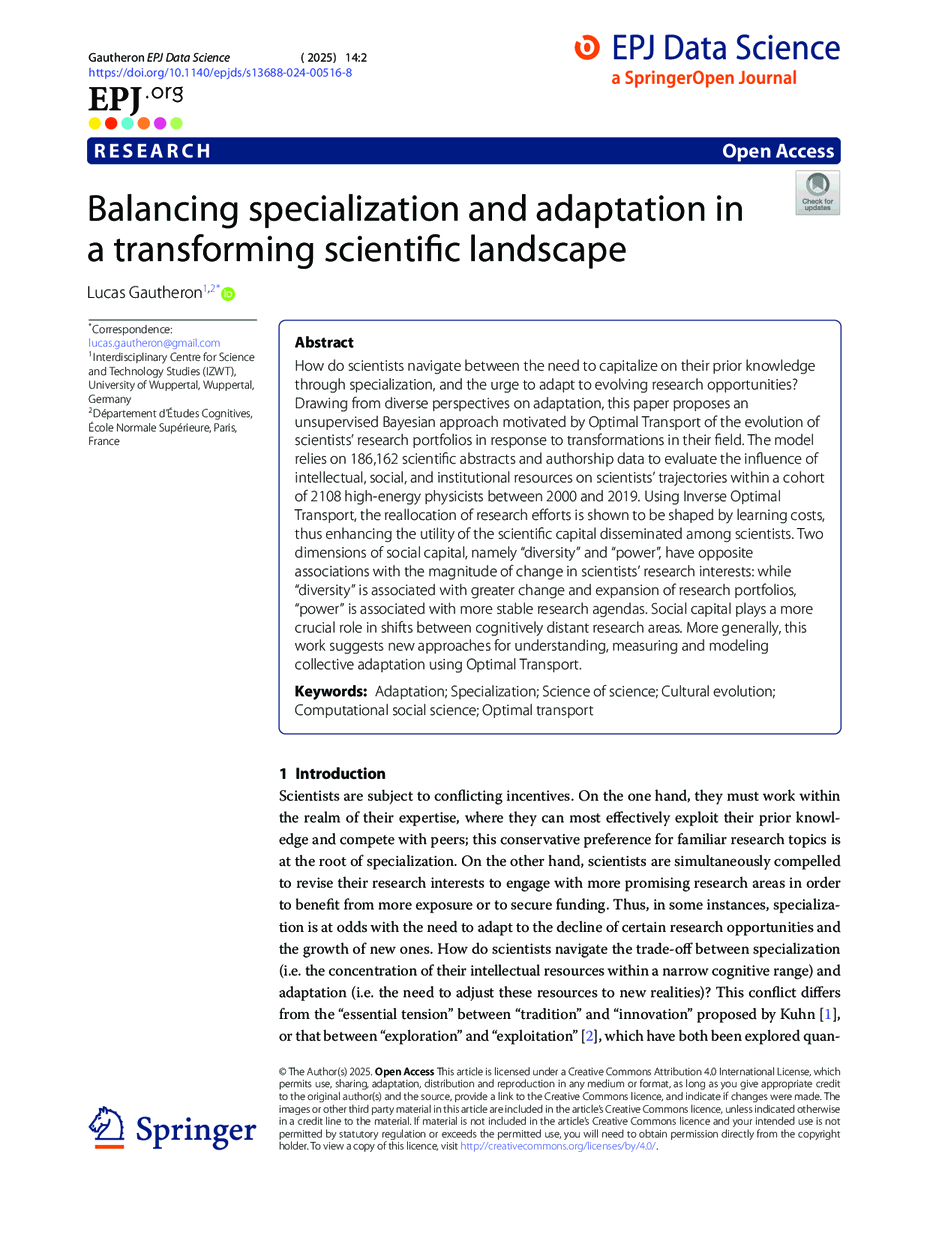https://doi.org/10.1140/epjds/s13688-024-00516-8
Research
Balancing specialization and adaptation in a transforming scientific landscape
1
Interdisciplinary Centre for Science and Technology Studies (IZWT), University of Wuppertal, Wuppertal, Germany
2
Département d’Études Cognitives, École Normale Supérieure, Paris, France
Received:
21
July
2024
Accepted:
19
December
2024
Published online:
8
January
2025
How do scientists navigate between the need to capitalize on their prior knowledge through specialization, and the urge to adapt to evolving research opportunities? Drawing from diverse perspectives on adaptation, this paper proposes an unsupervised Bayesian approach motivated by Optimal Transport of the evolution of scientists’ research portfolios in response to transformations in their field. The model relies on  scientific abstracts and authorship data to evaluate the influence of intellectual, social, and institutional resources on scientists’ trajectories within a cohort of 2108 high-energy physicists between 2000 and 2019. Using Inverse Optimal Transport, the reallocation of research efforts is shown to be shaped by learning costs, thus enhancing the utility of the scientific capital disseminated among scientists. Two dimensions of social capital, namely “diversity” and “power”, have opposite associations with the magnitude of change in scientists’ research interests: while “diversity” is associated with greater change and expansion of research portfolios, “power” is associated with more stable research agendas. Social capital plays a more crucial role in shifts between cognitively distant research areas. More generally, this work suggests new approaches for understanding, measuring and modeling collective adaptation using Optimal Transport.
scientific abstracts and authorship data to evaluate the influence of intellectual, social, and institutional resources on scientists’ trajectories within a cohort of 2108 high-energy physicists between 2000 and 2019. Using Inverse Optimal Transport, the reallocation of research efforts is shown to be shaped by learning costs, thus enhancing the utility of the scientific capital disseminated among scientists. Two dimensions of social capital, namely “diversity” and “power”, have opposite associations with the magnitude of change in scientists’ research interests: while “diversity” is associated with greater change and expansion of research portfolios, “power” is associated with more stable research agendas. Social capital plays a more crucial role in shifts between cognitively distant research areas. More generally, this work suggests new approaches for understanding, measuring and modeling collective adaptation using Optimal Transport.
Key words: Adaptation / Specialization / Science of science / Cultural evolution / Computational social science / Optimal transport
© The Author(s) 2025
 Open Access This article is licensed under a Creative Commons Attribution 4.0 International License, which permits use, sharing, adaptation, distribution and reproduction in any medium or format, as long as you give appropriate credit to the original author(s) and the source, provide a link to the Creative Commons licence, and indicate if changes were made. The images or other third party material in this article are included in the article’s Creative Commons licence, unless indicated otherwise in a credit line to the material. If material is not included in the article’s Creative Commons licence and your intended use is not permitted by statutory regulation or exceeds the permitted use, you will need to obtain permission directly from the copyright holder. To view a copy of this licence, visit http://creativecommons.org/licenses/by/4.0/.
Open Access This article is licensed under a Creative Commons Attribution 4.0 International License, which permits use, sharing, adaptation, distribution and reproduction in any medium or format, as long as you give appropriate credit to the original author(s) and the source, provide a link to the Creative Commons licence, and indicate if changes were made. The images or other third party material in this article are included in the article’s Creative Commons licence, unless indicated otherwise in a credit line to the material. If material is not included in the article’s Creative Commons licence and your intended use is not permitted by statutory regulation or exceeds the permitted use, you will need to obtain permission directly from the copyright holder. To view a copy of this licence, visit http://creativecommons.org/licenses/by/4.0/.





